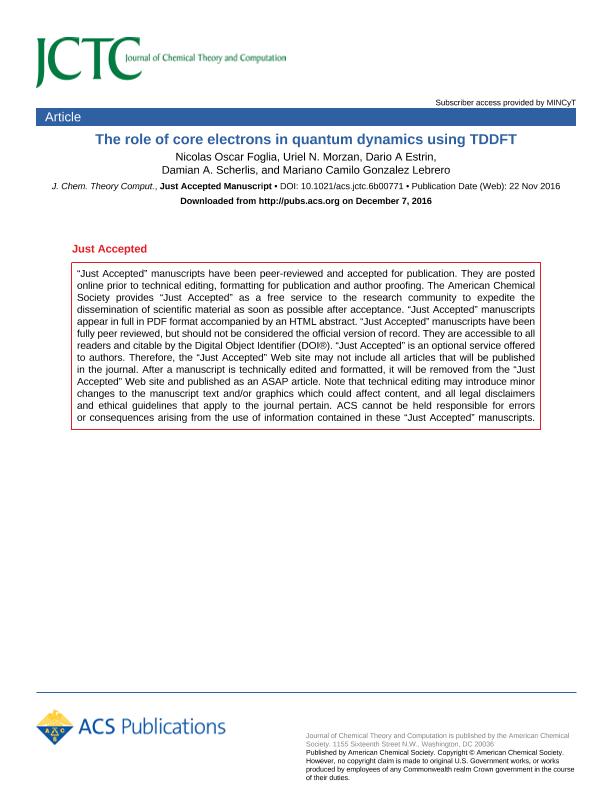Artículo
Role of core electrons in quantum dynamics using TDDFT
Foglia, Nicolás Oscar ; Morzan, Uriel
; Morzan, Uriel ; Estrin, Dario Ariel
; Estrin, Dario Ariel ; Scherlis Perel, Damian Ariel
; Scherlis Perel, Damian Ariel ; González Lebrero, Mariano Camilo
; González Lebrero, Mariano Camilo
 ; Morzan, Uriel
; Morzan, Uriel ; Estrin, Dario Ariel
; Estrin, Dario Ariel ; Scherlis Perel, Damian Ariel
; Scherlis Perel, Damian Ariel ; González Lebrero, Mariano Camilo
; González Lebrero, Mariano Camilo
Fecha de publicación:
01/2017
Editorial:
American Chemical Society
Revista:
Journal of Chemical Theory and Computation
ISSN:
1549-9618
Idioma:
Inglés
Tipo de recurso:
Artículo publicado
Clasificación temática:
Resumen
The explicit simulation of time dependent electronic processes requires computationally onerous routes involving the temporal integration of motion equations for the charge density. Efficiency optimization of these methods typically relies on increasing the integration time-step and on the reduction of the computational cost per step. The implicit representation of inner electrons by effective core potentials-or pseudopotentials-is a standard practice in localized-basis quantum-chemistry implementations to improve the efficiency of ground-state calculations, still preserving the quality of the output. This article presents an investigation on the impact that effective core potentials have on the overall efficiency of real time electron dynamics with TDDFT. Interestingly, the speedups achieved with the use of pseudopotentials in this kind of simulation are on average much more significant than in ground-state calculations, reaching in some cases a factor as large as 600×. This boost in performance originates from two contributions: on the one hand, the size of the density matrix, which is considerably reduced, and, on the other, the elimination of high-frequency electronic modes, responsible for limiting the maximum time-step, which vanish when the core electrons are not propagated explicitly. The latter circumstance allows for significant increases in time-step, that in certain cases may reach up to 3 orders of magnitude, without losing any relevant chemical or spectroscopic information.
Palabras clave:
Tddft
,
Pseudopotentials
,
Excitations
,
Electrons
Archivos asociados
Licencia
Identificadores
Colecciones
Articulos(INQUIMAE)
Articulos de INST.D/QUIM FIS D/L MATERIALES MEDIOAMB Y ENERGIA
Articulos de INST.D/QUIM FIS D/L MATERIALES MEDIOAMB Y ENERGIA
Citación
Foglia, Nicolás Oscar; Morzan, Uriel; Estrin, Dario Ariel; Scherlis Perel, Damian Ariel; González Lebrero, Mariano Camilo; Role of core electrons in quantum dynamics using TDDFT; American Chemical Society; Journal of Chemical Theory and Computation; 13; 1; 1-2017; 77-85
Compartir
Altmétricas



